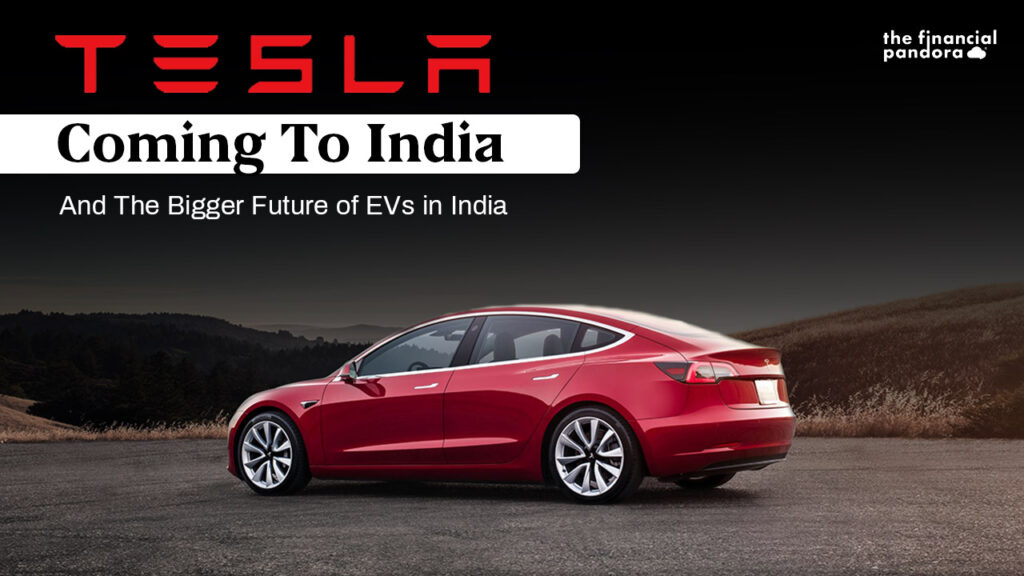Tesla’s entry in India has been a hot topic for nearly half a decade now. The consensus appears divided – while one group believes that the auto giant’s entry makes little sense in a country like India, the other group believes that it might be the next piece in Tesla’s jigsaw puzzle.
Before we get to a few possibilities about Tesla’s Indian presence and the broader future of EVs in India, let’s first understand why this is such a hot topic:
For starters, Tesla as a brand is arguably one of the most influential automakers of recent times. This may sound like a bold statement, but given how they’ve managed to take the entire automotive landscape from zero to one, I feel it’s a fair title.
This coupled with how valuable Tesla (and EVs in general) can be for the Indian automotive ecosystem, the hype feels justified.
Now, the two main problems that Tesla (or any other EV automaker may face) in India are likely to be:
- Electricity infrastructure
- Price
Problem 1 – Electricity infra
According to this report on a recent study conducted, 13% of Indian households (yes, all households) do not have access to grid-connected electricity. That’s a staggering amount. But let’s not let stats fool us.
You see, my opinion is that a huge chunk of these households belong to Tier-2 or Tier-3 cities. With the government’s initiatives on energy and electricity, the accessibility is there & improving. It ultimately becomes a question of actually setting up the physical charging stations. And there’s progress on that, too…
Newer companies like Ather have already begun setting up their own charging stations in certain areas. MG and Tata Motors have taken similar initiatives. Even the government has expressed plans to install charging stations at 69,000 petrol pumps across the country. So the infrastructural constraint that previously plagued the EV market may soon be a problem of the past.
How soon? No one can tell. But I feel the transition may be faster than one may expect.
The reason I say this is because Indians, especially those in tier-1 cities with higher incomes, are adopting to EVs faster than ever before. For instance, A January 2021 report suggested that 50% of all cars sold by Tata Motors were EVs. Fifty per cent. That’s an insane number for an idea that was dismissed as being too restrictive or too nascent not too long ago.
What I’m trying to get at is that EVs are not just a utopian thought anymore. The infrastructural logistical side of the equation is improving at an optimistic rate. And with every passing day, the optimism only seems more justified to me and many others.
Problem 2 – Price
Coming to price, there’s no beating around the bush – EVs are pricey. Tesla is even more so. Automakers always have a hard time justifying their entry into the Indian market due to how expensive cars here can be. This is especially true for more expensive cars that come in via the CBU (Completely Built Unit) route, aka, as completely built direct imports.
This attracts massive taxes. To take a very basic example, a BMW 530i starts at $54,200 in America. A similar model here starts at INR 56 Lakhs ex-showroom. That’s 42% more than its American counterpart for a car that’s assembled locally, aka, not a direct import via the CBU route. In other words, a car that is assembled locally (with reduced taxes than direct imports) is still ~42% dearer than one in America.
Taxation – the real Tesla “killer”?
Existing tax laws say that cars below $40,000 enjoy lower duties. The only Tesla falling in this bracket is the Model 3 Standard Range Plus, coming in at $37,990. Which means that every model other than the very basic one will attract higher duties. It also means that any optional extras we may want on our Tesla have to be under $2,010 or else the entire car will be taxed at a higher basic rate (100% vs 60%).
Other similarly priced cars cost between INR 90L to 1 Crs. (Porsche 718, Ford Mustang) which are ICE cars. Given FAME subsidies and other favourable policies for EVs, one could estimate a price bracket of INR 60-80 Lakhs onwards, all the way to INR 1.5-2 Crs. for a Model X. The Tesla Roadster, priced at $200,000 could cost approximately INR 3 Crs. landed.
One argument to be made here is that EVs enjoy some benefits. But those are relatively insignificant for a car purchase north of INR 50 Lakhs.
Can Tesla set up in India?
A way to reduce costs would be to set up in India by operating a factory locally. But since Tesla has recently invested in a Giga-factory in China and America, it is unlikely to me that India would see a Giga-factory soon.
While initial interest was present, the authorities were unwilling to provide sufficient incentives. This means that it is most likely that we see Tesla coming in via the CBU route, at least initially, unless a partnership with an Indian company having a manufacturing plant is struck, in which case a CKD (Completely Knocked Down, aka importing parts and assembling locally) entry might be possible.
This is important because of two main reasons:
- Costs: CBUs are taxed at a higher rate than CKDs.
- Features: Enabling or removing features requires a facility.
For instance, Indian laws on radar usage for private vehicles had several restrictions. Even local brands had to disable certain features and such due to radar frequency laws.
Other brands have various region-specific features. Unless Tesla has a local facility, making these changes once the car lands in India is a challenge. A workaround is to ship Indian-spec cars from the factory directly. Which would still add a delay and make the company less flexible and agile.
So unless Tesla invests serious funds in the Indian market, either for assembly for local sales (sounds infeasible) or for export to other countries (makes sense, but they already have China), Tesla might not have the cost advantage here.
But Tesla doesn’t need to have a cost advantage unless they aim to compete in the lower segment of the premium market. Niche brands like Lexus are present in the Indian market with premium offerings and enjoy a cult following.
Are higher costs even a factor?
The price might seem very, very high at first, but here’s the kicker – the steep price hasn’t stopped Indians from importing these cars privately. There are a handful of Teslas in the country, with two noteworthy owners being Mukesh Ambani (Reliance Industries) and Prashant Ruia (Essar). Granted these are individuals with immense financial resources, but it goes to show that individuals may be willing to dig deeper into their wallets for a Tesla.
And while these figures are specific to Tesla, I do not rule out the possibility of other manufacturers seeing similar results. For instance, Mercedes recently launched the EQC in India at a price of INR 1.05 Crs. ex-showroom. The same car costs around $69,000 stateside. That’s almost as much as a fully-optioned Model 3 with Full Self Drive.
Jaguar is set to launch the I-Pace in India soon (March 9th). This launch may provide additional insight into the market dynamics for higher-end EVs in India. But I’m not sure if Jaguar’s and Mercedes’s performance could be a good benchmark for Tesla’s.
One defining factor that may dictate Tesla’s growth trajectory in India could be something that’s completely unrelated to finance, and that’s marketing.
Tesla’s real defining factor
You see, as a finance professional, it’s very difficult to justify Tesla’s entry in the country. It’s even harder to try and begin to make the operation sound profitable even if we run the numbers multiple times. On a lighter note, this almost reminds me of Tesla’s stock, but I digress.
The one differentiating factor that Tesla undeniably has is marketing. With Elon’s strong personal brand at the helm of an already innovative company with a great product, Tesla has pretty much nailed the marketing side of things without spending a single penny on it.
If the Indian buyer sees the aspirational value in owning “a piece of the future”, Tesla might just move all financial models to the recycle bin and emerge as an unexpected winner in the race of EVs in India.
When Tesla first launched the Model 3 some four years ago, they opened bookings for India, too. Many put in their deposits to book their slot and many are still happy to wait even though nothing’s come of it yet. As we know, healthy pre-orders show a company potential in the market + give it cash. This means that, in theory, India was already a revenue-generating market for the automaker well-before they even registered themselves as a legal entity in the country!
And coming to their recent registration, the hype it gained really goes to show how much of a fan following the brand has. And while not everyone from those excited about the brand’s entry may be buyers of their cars right now, it does show us the aspirational value that Teslas carry.
It does show that several Indians are willing to spend serious money to buy a Tesla even if they wouldn’t spend similar amounts for a “regular” car.
This might sound overly optimistic at first, I admit. But I feel we cannot analyze an unconventional automaker with conventional methods.
On paper and in numbers, the brand’s entry might not make sense. In fact, even Tesla’s Indian office is nothing but a single desk at a co-working space. But let me ask you this – when was the last time the internet (and not just car enthusiasts) went into a frenzy after an automaker registered itself with the RoC?
Wrapping it up...
To conclude, there are some glaringly obvious uncertainties and downsides to the auto giant’s Indian entry. In fact, the future of EVs as a whole seems quite utopian at first thought, but let’s think of things from a different angle:
Most people think of Tesla’s entry from an end-user point of view. You know, average Joes like you and me who, if in the market for one, will probably look at a Model S/3/X/Y or something “regular”. But the area where Tesla and EVs can have the most impact is in the commercial space.
The logistics industry may have its own set of problems, but to me, electrifying commercial vehicles seems like the perfect way to incorporate EVs into the Indian ecosystem. Tesla has their Semi and with time, other brands will have potent offerings, too. With time, the electricity infrastructure will broaden and improve.
Environmental benefits aside, this will lead to cost savings & efficiencies of its own. And it’s a future I’m hoping soon becomes reality…
This post was written in collaboration with Asif Yahiya Sukri LLP. Asif Yahiya Sukri LLP provides unparalleled personalized financial services to a broad range of clients across different geographical locations. With a presence in the USA, India and the MENA region, they ensure that all of your financial decisions are made carefully and with your best interests in mind. They are innovators who understand what goes into building companies.
You can also reach out to them on info@aysasia.com
Follow Us @




